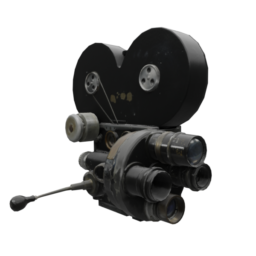Bell & Howell

Bell & Howell Podcast (5:15)
Note: Text in square brackets describes the soundscape as well as certain specific or occasional sounds.
[Ambience of a suburban backyard in the middle of summer: birds, insects, wind. Charlie, the narrator’s dog, barks. He is chasing birds. We hear birds flying away as the dog continues to bark]
Narrator: Charlie! Hey! Sit down, Charlie! Sit!
[Narrator sighs]
My dog refuses to sit still; he just wants to chase birds! No, Charlie! Stay! Hey! Charlie!
[Birds fly away while the dog is still barking]
[Theme music begins: soft piano melody]
Narrator: In my film class, we watched a silent movie from the 1910s. And now, as homework, I have to shoot a silent scene, with no dialogue. So I came up with the idea of directing my dog, but shooting a film with an animal is really complicated! If Charlie doesn’t stay still, I can’t frame my image properly with my phone. And my movements are way too shaky! Even with the automatic functions, I can’t keep the focus on Charlie if he’s constantly moving around.
[Charlie barks]
Narrator: In the early days of Hollywood cinema, how did filmmakers manage to shoot well composed, in-focus images of animals like Charlie? Was it even possible?
[Intro music end]
[Sound of a camera rolling. A director shouts ‘And… cut!’ The sound of the camera stops. We hear footsteps and voices of a film crew moving around]
Narrator: Between the late 1910s and the late 1920s, the Bell & Howell was the camera that was most used by major Hollywood studios. All of the renowned cinematographers of that time worked with the Bell & Howell at one point or another in their careers.
Founded in 1907, the Bell & Howell company specialized in repairing film equipment. After creating a wooden film camera that didn’t meet the associates’ expectations, the company created their famous model 2709, a metal camera that uses 35mm film. The year is 1912.
[On the film set, we hear a big dog panting and barking. A woman says “Good boy! Good boy!”]
Narrator: Seven years later, during the film shoot of the highly successful silent film Back to God’s Country in 1919, the star and screenwriter of the film Nell Shipman kneels down next to a Great Dane named Wapi. Shipman and Wapi – a dog with remarkable acting abilities! – are in a film studio in front of a Bell & Howell camera. To make sure that Shipman and Wapi are well lit, the film crew uses strong artificial lights that are easy to control.
As Nell Shipman hugs Wapi’s head, the Bell & Howell camera operator places his lens in front of the camera’s innovative eyepiece system to frame his image. This preview of the shot allows the camera operator to create a beautiful composition and to ensure that the image is in focus. But the preview isn’t perfect: the eyepiece produces a slight parallax effect, which means that the cameraman’s glimpse of the shot doesn’t represent the exact frame that will be captured by the camera when recording.
Nicknamed ‘Mickey Mouse Ears,’ the Bell & Howell is about three times the size of a PlayStation video game console, and about the same weight as two bowling balls. The Bell & Howell is placed on a sturdy tripod with two cranks. These cranks allow the cinematographer to point the camera up, down, to the left or to the right during a take.
Oh – the cameraman is ready to shoot!
[A man gives directions to the staff on the set. The director shouts ‘And… action!’ The Bell & Howell sound resumes, accompanied by a soft keyboard music]
Narrator: At a speed of 2 turns per second, the operator cranks the Bell & Howell to shoot at a frame rate of 16 frames per second. Shipman pets Wapi on the head and hugs him. If he wishes to do so, the camera operator can vary the speed of the shot to create fast or slow-motion effects. This is just one example of an in-camera effect that is made possible by the Bell & Howell. In Back to God’s Country, there are fade-ins, aperture changes, and overlapping images. It’s really impressive that these effects were already possible in 1919!
[The camera sound and the music end]
[Ambience of the narrator’s backyard. Her dog Charlie barks. Suddenly, there is a loud splash. The narrator laughs softly]
Narrator: Charlie! You’re so clumsy!
[The dog comes out of the pool and shakes the water off of his fur. He pants.]
Narrator: Here’s another interesting fact: on top of being a Hollywood-based Canadian actress, writer, producer, and director, Nell Shipman, the star of Back to God’s Country, was also a professional animal trainer and advocate. In the feature film, Shipman acts not only alongside Wapi, but also alongside a family of bears!
[Charlie barks. Birds fly away. He shakes his fur again beside the narrator.]
Narrator: Oh! Charlie! Now I’m soaked too… and I haven’t even finished my homework! I’m going to need a lot of treats for you if I you’re going to be as good as Wapi!
[Theme music begins plays again]
Narrator: To discover more cameras, listen to the other podcasts.